Renewal at the Santa Barbara Museum of Art
New Facilities, New Experience Achieved Through Major Renovation
By Charles Donelan | August 12, 2021

Every museum tells a story; great museums tell many of them.
On Sunday, August 15, the Santa Barbara Museum of Art begins a new chapter, perhaps the most significant such turning point since its inception in 1941. After nearly seven years of construction, and at an expense of more than $50 million, the entire building at the corner of State and Anapamu streets has been seismically retrofitted; its complex security, storage, and climate-control systems overhauled; and its galleries reimagined to better serve the tastes and interests of a new century.
Without losing the delicate balance between preservation and innovation, the project offers visitors a fresh experience not only of the museum’s extraordinarily significant collections but also of the ways in which they represent the aspirations of Santa Barbara, a city long identified as exceptional. The new Santa Barbara Museum of Art (SBMA) feels destined to center an enlightened community through the pursuit of thoughtful and enduring visions of an ideal life.
In the decades following the 1925 earthquake, Santa Barbara got a makeover that has had a determining impact on the direction of the city ever since. Inspired by the great architectural achievements of Bertram Goodhue, George Washington Smith, Lutah Maria Riggs, and others and driven by the charismatic leadership of Pearl Chase, the city adopted its distinctive Spanish Colonial style and created the civic bureaucracy necessary to enforce it. In step with this wholesale reimagining of the built environment, there was a kind of Santa Barbara renaissance, complete with music, theater, film, and dance.
In the midst of this most ambitious time — the first half of the 20th century — worldly (and wealthy) people came together in support of the idea that the city should have a museum comparable in quality to the private art collections hereabouts. To this end, the old post office building was acquired, and modifications began of which we are now seeing the latest iterations.
Why All the Work?
The post office building on which the current SBMA is based is more than 100 years old. It survived the earthquake of 1925 and provides the foundation for the museum we enjoy today. As anyone with experience maintaining property will tell you, 100 years is a very long time.
For Larry Feinberg, whose CEO post at the museum is officially titled the Robert & Mercedes Eichholz Director, this project has been an all-consuming one since it began shortly after his arrival in December 2007. Feinberg knew that this work needed to be done, and he also knew that he and the museum’s board were in agreement that the solution lay in a thorough renovation of the existing structure, rather than in an entirely new building. Even if it meant rebuilding everything from the foundation up, this would be a renovation and not a tear-down.
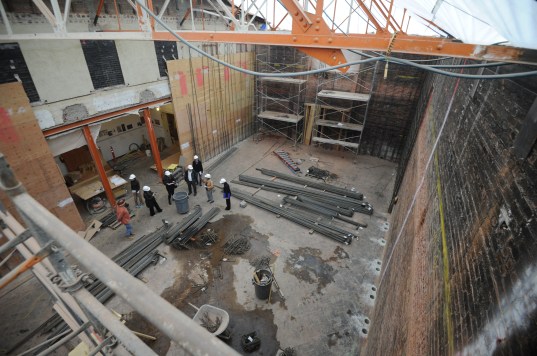
Having seen how the escalating costs of new buildings by famous architects could devastate the bottom lines of other museums, Feinberg was determined that this would not happen in Santa Barbara. Thanks to the tireless work of a large team in adapting to changing conditions along the way, and to the support of a loyal community of conscientious donors, this project will be completely paid for by the time it opens to the public on Sunday, August 15. No bonds, no loans, no accounts outstanding — a remarkable achievement for which many generous Santa Barbarans deserve credit.
Like almost every renovation project of any scale, this one hit some unexpected challenges along the way. In fact, the first three years of the work involved a forensic approach to the building, in which layers were peeled away, no one knowing what might be underneath.
For example, the large McCormick Gallery on the side of the museum toward the courthouse, which was added to the original post office structure shortly after the museum first opened in the 1940s, turned out to be not a solid structure. Rather, to quote Feinberg, it was “a pile of bricks” with one wall — the one facing the old building — never completed. Years of hanging major shows and hosting large events in this earthquake-prone region without understanding the flimsiness of this seemingly substantial room are thankfully now just unsettling memories.
Today, the McCormick Gallery is completely reinforced with a steel cage superstructure and giant helical piles screwed deep into the earth so that, according to Feinberg, “in the event of an earthquake, we won’t be pitched up.”
A Good Neighbor
Major improvements to the ways in which the museum handles and stores art will transform the building’s impact on Anapamu Street and the courtyard facing the Santa Barbara Public Library Main Branch. The new loading dock on Anapamu can accommodate much larger and heavier objects than ever before, an important consideration given both the ambitious scale at which many contemporary artists choose to work, and the constraints on the lending of valuable artworks, which must be insured against any damage that might occur not only on-site but also in transit.
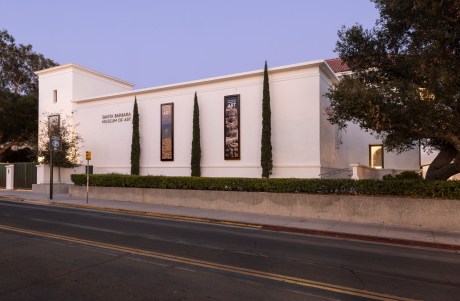
When the City of Santa Barbara evaluated the museum’s initial plans for this loading dock, it specified that, however big the museum wanted to go with its freight elevator, trucks could not block the sidewalk on Anapamu Street. As a result, the elevator was constructed so that when it is fully open, a 40-foot 18-wheeler can back into the building so far that the cab vanishes off the sidewalk.
Similar “good neighbor” features abound in the signage and the redesign of the State Street entrance and ticketing area. The decision to keep the museum open during the construction period has had at least one unintended positive result, which is that the staff has had a chance to live through the repurposing of State Street as a pedestrian mall. The new signs on State Street are attuned to the new level and type of activity out front, and the accessible ramp entrance leading up to the reception area from Anapamu Street blends well with the promenade atmosphere. The museum now participates fully in the flow of street life that animates this exclusively ambulatory portion of the city’s historic arts district.
On View from Now On
Like major museums in larger cities, the SBMA has more than one area of strength. The collections of Greek and Roman antiquities, Asian art and antiquities, 19th- and 20th-century European painting, and 19th- and 20th-century American painting are all considered world-class, as are more recently acquired holdings in photography and contemporary art. These collections represent the legacy of generous donors and ambitious, scholarly curators. People such as Karen Sinsheimer and Charlie Wylie in photography, Susan Tai in Asian art, James Glisson and Julie Joyce in contemporary art, and Eik Kahng as chief curator have built these collections object by precious object over decades.
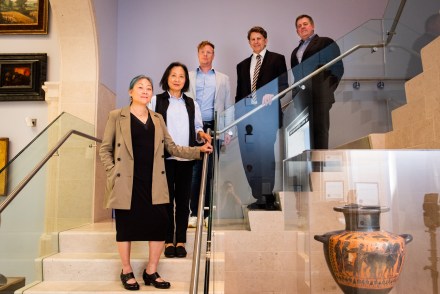
Thanks to the new galleries, more work than ever before will be on display. For Director of Education Patsy Hicks, that’s a key advantage: “The new galleries, above all, offer us the opportunity to share more of the museum’s collection with visitors. To reacquaint them with longtime favorites and introduce them to many powerful and provocative new works is truly a delight.”
All of these areas, plus a new media section under the curatorship of Wylie, now have permanent spaces where they will be on display continuously, with works from the archives rotating through galleries devoted to each medium. Although this reconfiguration represents an advance for photography and contemporary art in particular, Feinberg maintains that the optimum ratio of more recent to older art has been preserved. He feels that “a number of encyclopedic museums have become too narrowly focused on contemporary work in recent years,” and he is determined to “keep the balance” in Santa Barbara by maintaining active gallery space for art from before the 20th century.
The Return of the ‘Lansdowne Hermes’
Which raises an interesting question: What single work best exemplifies the Santa Barbara Museum of Art?
Despite a ravishing abundance of great candidates, from a historical point of view there’s only one answer, and that’s the giant Roman sculpture known as the “Lansdowne Hermes.” This monumental male nude, a Roman copy of a Greek original circa 1st-2nd century CE, has been in Malibu while the renovation was completed, “having some work done” at the Getty Villa.
Now Hermes is back and featured more prominently than ever, occupying the center of the Ludington Court and anchoring the museum’s important collection of Greek and Roman antiquities. The “Lansdowne Hermes” holds a special place in the story of the SBMA, and he and his provenance deserve a moment of close attention in celebration of his return from the Getty. Welcome home, Hermes!
Where to start? The sculpture is massive, more than life-sized, and gloriously detailed, with a surface as white as, well … marble, which is what it is made from. Imagine a version of Michelangelo’s “David,” but in downtown Santa Barbara, and fully pagan.
Created in celebration of the success of the Roman empire, the “Lansdowne Hermes” could hardly be more compelling — or vexing, depending on your perspective — as a representation of the achievements and outsized self-images of powerful men. He and his spectacular abs languished during the Christian Middle Ages, only to be exported from Italy to London by a British aristocrat in the later 18th century. Hermes became a Lansdowne when he was acquired by William Petty-Fitzmaurice, the first Marquess of Lansdowne, and put on display in London as part of what was at the time the world’s most impressive private collection of Roman sculpture outside of Italy.
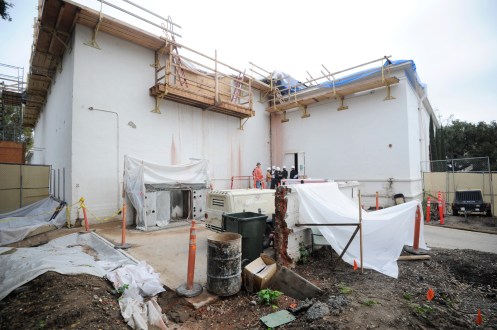
An enlightened imperialist, Lansdowne was friends with Benjamin Franklin and drafted the British side of the agreement that ended the American Revolutionary War. Although his success at international diplomacy failed to earn him further such responsibilities, if Lansdowne had not been rejected by King George, he might never have become a collector. In the years following his exit from diplomacy in 1783, Lansdowne backed the work of British archaeologist (some might say cultural vandal) Gavin Hamilton. Based on Hamilton’s advice, Lansdowne assembled a collection of antiquities to rival that of the Vatican, his most frequent competitor in the race to own objects being dug up around Rome circa 1780.
Fast-forward to the early 20th century, and the westward expansion of global capitalism, along with the worldwide Great Depression, had rendered Lansdowne’s 18th-century windfall a 20th-century liability. That’s when the Lansdowne family began to liquidate the collection, selling the statues to the highest bidder. Three Americans led the charge to acquire these priceless artifacts. Two of the names you will surely recognize, and the third you should.
William Randolph Hearst was the first Californian to get in on the Lansdowne yard sale, followed by J. Paul Getty. Both of them acquired extraordinary works, Hearst to display at Hearst Castle and his other homes, and Getty to eventually form the basis for the Getty Center collection. The third man to make significant purchases from the Lansdowne collection was Wright Saltus Ludington of Montecito. In July 1930, Ludington paid $20,000 for the “Lansdowne Hermes,” and he got a bargain. Almost a hundred years later, the piece is still considered by many to be the most important work of classical sculpture on the West Coast.
From 1930 until 1955, the big man stood outside in the garden at Val Verde, a Roman-inspired fantasy designed for Ludington by Lockwood de Forest. When Ludington moved to Hesperides, his second (of three) Montecito estates, the “Lansdowne Hermes” moved indoors, where he occupied a specially designed niche in the house’s extravagant living room. British society interior decorator David Hicks, who visited Hesperides in 1957, described the space as “one of the most exciting and attractive rooms in the world.”
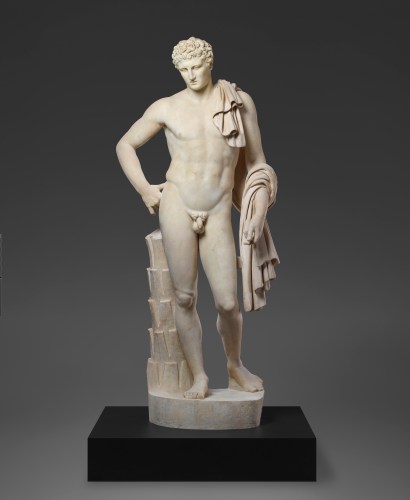
Most of Hearst’s Lansdowne acquisitions ended up at LACMA, and, of course, we all know where the Getty prizes went: to the villa in Malibu. Ludington’s Lansdowne horde, which included several other important works, stayed in Santa Barbara and formed the basis for the new Santa Barbara Museum of Art when it was founded in 1941.
Although he was endowed with similar means and ambition, Ludington was not like Hearst or Getty in his taste and sensibility. His was a different vision. As a gay man living more openly as such in Montecito than he could have done nearly anywhere else in America, he saw the global art market with a distinctly queer eye, and by that I do not mean that he focused exclusively on antiquities or on male figures. In fact, quite the opposite. His forte as a collector was his openness to the strengths of different cultures and periods, and to the excitement that happened when they were brought together.
Of the three powerful Americans who bid successfully on the Lansdowne antiquities, Ludington was the only one who also saw the value of the new painting that was happening in Paris in the 1920s and 1930s. As a result, from the same initial benefactor who provided the Santa Barbara Museum of Art with the “Lansdowne Hermes,” we also have many of the museum’s most important works of modern art, including not a few paintings by Picasso. The Lansdowne pieces — there are several others, including a torso of Dionysus — were on loan to the museum until 1978, when Ludington began granting them to the museum’s permanent collection, a process completed upon his death in 1992.
So, when you enter the freshly reimagined Ludington Court and gaze on the towering central figure, remember that this museum carries within its DNA the double consciousness of an outsider, someone for whom the spoils of empire held meanings not wholly consistent with more conventional notions of how power operates and is expressed. In mythology, Hermes signifies the crossing of boundaries between different worlds, and the carrying of messages from one to the other.
In the single most significant gesture of the renovation, the rear of the Ludington Court is now taken over by a grand staircase that leads upward to a new rooftop gallery of contemporary art that’s flooded with natural light. It’s a fitting tribute to the messenger god below, and a marvelous addition to the sublime experience that is the new Santa Barbara Museum of Art.
See sbma.net.




You must be logged in to post a comment.